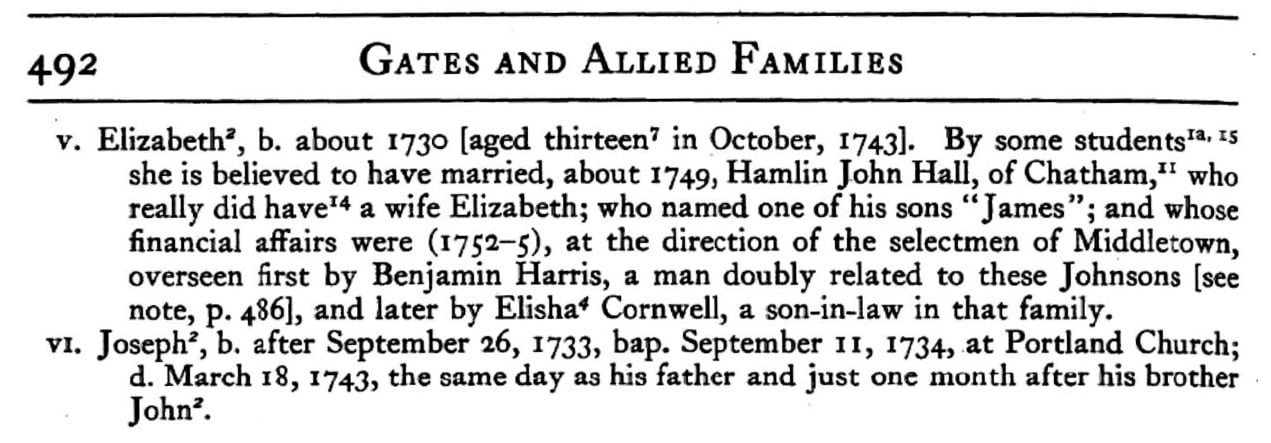 Many of us are avid genealogists who want to trace our ancestry as far back as is reasonable in all lines. When filling out our family trees, we come to some dead ends where lack of information blocks us from going back further. We may also come to situations where there is some information relating to the parentage of a known ancestor but not enough to claim certainty.
Many of us are avid genealogists who want to trace our ancestry as far back as is reasonable in all lines. When filling out our family trees, we come to some dead ends where lack of information blocks us from going back further. We may also come to situations where there is some information relating to the parentage of a known ancestor but not enough to claim certainty.
I have several uncertain situations in my American ancestry. For example, I have a tantalizing possible descent from the Mayflower passengers Stephen and Elizabeth Hopkins and Francis Cooke; all three would be new Mayflower ancestors for me if a link supported by circumstantial evidence (discussed in Dawes-Gates 2: 492) is correct.
The hazard in dealing with any situation with uncertainty is that there is a temptation for appealing possibilities to become probabilities and appealing probabilities to become near certainties. However, overly zealous avoidance of this hazard can lead to throwing away information, and I hope to show here how nuggets of certainty can in some cases be extracted (without compromising integrity) from situations of uncertainty.
Let’s imagine that you know the father of a particular female ancestor but are uncertain about the mother. Specifically, suppose that the father had two wives, and you don’t know (and can’t easily find out) which of them is the mother of the daughter. How will you deal with this uncertainty?
A less restrictive approach would be to “peek” at the ancestry of the two wives...
If you are entering your genealogical data into a database or writing an account of your ancestry, you will no doubt report some data about both wives, but how far will you delve into their ancestry? The most conservative approach would be to report their parents and go no further until you find new information which might help you decide which wife is likely your ancestor. A less restrictive approach would be to “peek” at the ancestry of the two wives and begin to satisfy your natural curiosity about the new ancestors that each of them could add to your family tree.
However, I will advocate here that even before the uncertainty is resolved, there is no disadvantage in researching and reporting as much of the ancestry of both wives as can be traced. Especially if the uncertain mother appears a number of generations before the root person (e.g., you) in generation 1 in the family tree, the extra work in tracing both potential mothers is not particularly great. For example, if the uncertain mother is in generation 7 and there are no other uncertain parents in that generation, then when working on tracing all branches of the ancestral tree, you would be researching 65 people in that generation rather than 64.
In particular, in this two wives situation a potential benefit in tracing the ancestry of both wives is that they might be cousins of some sort. Suppose they are third cousins, having two great-great-grandparents in common. Assuming there are no mistakes in the paper trail which supplies the cousin relationship, the shared ancestors of these two wives are definitely ancestors of yours (or whoever occupies the generation 1 slot in the family tree on which you are working), independent of which of the two wives in generation 7 is the mother of your ancestor in generation 6. This is a nugget of certainty which you can extract from the uncertainty connected with the question about which of the two wives is your ancestor.
If one or more of the shared ancestors of these two wives were participants in some significant historical event, you might be stimulated to learn more about this event, given that you know you are descended from some participants, even if you don’t know the exact routes.
"We haue the rather noted these thinges, that you may see the worth of these things..."
Further, consider the apparently even more tenuous case where you don’t find any common ancestors shared by the two wives, but you find ancestors of those wives who have had some shared experiences. For example, wife 1 may be descended from Mayflower pilgrim A and wife 2 may be descended from Mayflower pilgrim B. In that case you can read William Bradford’s Of Plymouth Plantation knowing that it chronicles the saga of one or more of your ancestors, and in so doing you will be potentially fulfilling some hopes expressed by Bradford: “We haue the rather noted these thinges, that you may see the worth of these things, and not necligently loose what your fathers haue obtained with so much hardshipe.”[1]
Note
Share this:

About Don Stone
Don Stone is a retired computer science professor. His interest in genealogy began at the age of 13 when his mother told him that he was descended from the artist John Trumbull. Some library research quickly revealed that he was descended from the artist’s brother, but he was hooked on the subject. Don enjoys researching modern, medieval, and ancient genealogy and making large-format illustrated genealogical charts. He received a Bachelor of Engineering Physics from Cornell University and an M.S. (Computer and Information Science) and a Ph.D. (Instructional Systems) from the University of Pennsylvania.View all posts by Don Stone →